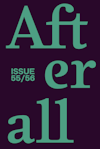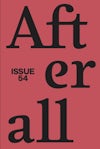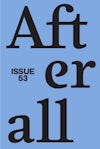
Issue 6
Autumn/Winter 2002
Editors: Charles Esche, Thomas Lawson, Mark Lewis, Silke Otto-Knapp, Zoe Crosher.
Founding editors: Charles Esche, Mark Lewis.
Table of contents
Foreword
Contextual Essays
- Looking for Something to Read – Thomas Lawson
- Small Gestures in Specific Places: Communication and Topography – Nikos Papastergiadis
Artists
Laylah Ali
- Almost Comic: The Art of Laylah Ali – Darby English
- Hanna Barbarity – Joel Smith
Chantal Akerman
- Images of an Indivisible Order – Raymond Bellour
- These Shoes Are Made for Walking – Bérenice Reynaud
Allen Ruppersberg
- Allen Ruppersberg: Certain of His Books – Susan Morgan
- ‘For nobody knows himself, if he is only himself and not also another one at the same time…’ – Frances Stark
Sean Snyder
- Jump Cut Cities – Jan Verwoert
- The Slobozian Question – Charles Esche
- Ducks, Gambling and Cultural Bankruptcy, or The Bastardised Urban Landscape – Marjetica Potr?
Helen Levitt
- Four Photographs by Helen Levitt: One from the Forties, Three from the Eighties – Judy Linn
- Useless Reportage: Notes on Helen Levitt’s In the Street – Roy Arden
Foreword
Written by Charles Esche & Thomas Lawson
From this issue onwards Afterall has a new joint editor, a new base in Los Angeles and a new set of ambitions to take the ideas of the journal forward…
From this issue onwards Afterall has a new joint editor, a new base in Los Angeles and a new set of ambitions to take the ideas of the journal forward. In broadening our editorial collaboration, we are seeking to secure the existing qualities of the journal as a critical voice steering a line between presenting artists and their work and providing theoretical contexts that add possibility and engagement to our encounters with art.
We also want to test the fashionable ideas of global sameness against the reality of a bi-polar publication that will have to take account of both an Anglo-Saxon and continental European view of art, and even of society as a whole. The extent to which these outlooks and expectations differ is arguably one of the most crucial cultural questions of the moment. At a time when the United States appears uneasy with its imperial role, and continental Europe seeks and repeatedly fails to define itself as a collective interest, the room for misunderstandings, creative and destructive, has rarely been larger since 1945. In the field of visual culture, this state of affairs might represent itself in mutually separate development, or in the rather piecemeal adoption of theories from ‘the other side’ that marked the appearance of post-1968 French theory in the United States or the understanding of the New York journal October‘s position in 1980s Germany. Neither process produced much in the way of stimulating art nor illuminating writing in their adopted homes, and there is no need to relive such histories. Nevertheless, the attempt to find ways in which the different trans-Atlantic positions can be expressed, critiqued and maybe even negotiated without seeking a banal synthesis is vitally important. Having been founded in the transit-lounge space of the United Kingdom gives us one perhaps ideal location to do so. Los Angeles is another, relating less to Europe than its Pacific Rim counterparts further west.
Purchase
The publication is available for purchase. If you would like specific articles only, it is also available individually and to be downloaded as PDFs.
Purchase full publication
Buy via University of Chicago Press
Buy via Central Books
Purchase individual articles
Buy via University of Chicago Press



